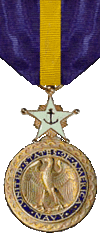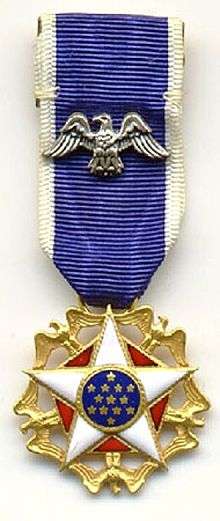Joseph Rochefort
| Joseph John Rochefort | |
|---|---|
 Joseph Rochefort | |
| Born |
May 12, 1900 Dayton, Ohio, USA |
| Died |
July 20, 1976 (aged 76) Torrance, California, USA |
| Place of burial | Inglewood Park Cemetery, Inglewood, California, USA |
| Allegiance |
|
| Service/branch |
|
| Years of service | 1918-47, 1950-53 |
| Rank |
|
| Commands held | Station Hypo |
| Battles/wars |
World War II Korean War |
| Awards |
Navy Distinguished Service Medal Presidential Medal of Freedom |
Joseph John Rochefort (May 12, 1900[1] – July 20, 1976) was an American Naval officer and cryptanalyst. His contributions and those of his team were pivotal to victory in the Pacific War.
Rochefort was a major figure in the United States Navy's cryptographic and intelligence operations from 1925 to 1946, particularly in the Battle of Midway.
Early career
Rochefort was born in Dayton, Ohio.[2] In 1917, he joined the Navy while still in high school in Los Angeles. He enlisted in the Navy in 1918. He was commissioned as an ensign after graduation from the Stevens Institute of Technology, and in 1919 became engineering officer of the tanker USS Cuyama.[3]
A fellow officer observed that Rochefort had a penchant for solving crossword puzzles and adept skills at playing the advanced card game auction bridge and recommended him for a Navy cryptanalysis class in Washington, D.C.[3]
Rochefort's tours ashore included cryptanalytic training under Captain Laurance Safford as his assistant,[3] and worked with the master codebreaker Agnes Meyer Driscoll in 1924.[4]
He then served a stint as second chief of the Division of Naval Communications' newly created cryptanalytic organization, OP-20-G, from 1926 to 1929; training in the Japanese language from 1929 to 1932; and a two-year intelligence assignment in the Eleventh Naval District, San Diego, from 1936 to 1938. Until 1941, Rochefort spent nine years in cryptologic or intelligence-related assignments and fourteen years at sea with the U.S. Fleet in positions of increasing responsibility.
World War II
Pearl Harbor
In early 1941, Laurance Safford, again chief of OP-20-G in Washington, sent Rochefort to Hawaii to become Officer in Charge of Station Hypo ("H" for Hawaii in the Navy's phonetic alphabet at the time) in Pearl Harbor as Rochefort was an expert Japanese linguist and trained cryptanalyst.
Rochefort handpicked many of HYPO's staff, and by the time of Pearl Harbor, had gotten many of the Navy's best cryptanalysts, traffic analysts, and linguists, including Joseph Finnegan. Rochefort's team was assigned to break the Japanese Navy's most secure cypher system, the Flag Officers Code,[5] while Navy cryptographers at Station CAST (Cavite in the Philippines) and OP-20-G in Washington (NEGAT, "N" for Navy Department) concentrated on the main fleet cipher, JN-25.[6]
Rochefort had a close working relationship with Edwin T. Layton, whom he first met on the voyage to Tokyo where both men were sent to learn Japanese at the Navy's request. In 1941, Layton was the chief intelligence officer for Admiral Husband E. Kimmel, Commander in Chief, Pacific Fleet (CINCPAC). Both he and Rochefort were denied access to decrypts of diplomatic messages sent in Purple, the highest level diplomatic cypher, in the months before the Japanese attack, on the orders Director of the War Plans Division, Richmond K. Turner.[7] That this would have helped is in question.
Battle of Midway
After the Japanese attack on Pearl Harbor, Navy cryptographers, with assistance from both British cryptographers at the Far East Combined Bureau (in Hong Kong, later Singapore, later Ceylon), and Dutch cryptographers (in the Dutch East Indies), combined to break enough JN-25 traffic to provide useful intelligence reports and assessments regarding Japanese force disposition and intentions in early 1942. Rochefort would often go for days without emerging from his bunker, where he and his staff spent 12 hours a day, or even longer, working to decode Japanese radio traffic. He often wore slippers and a bathrobe with his khaki uniform and sometimes went days without bathing.
Station HYPO maintained the coming Japanese attack would be in the Central Pacific, and convinced Admiral Chester W. Nimitz (who replaced Kimmel). OP-20-G (with support from Station CAST) insisted it would be elsewhere in the Pacific, probably the Aleutian Islands.[8] possibly Port Moresby in Papua New Guinea, or even the west coast of the United States.[9] OP-20-G, which had been restructured (Safford having been replaced by Commander John Redman, a communications officer untrained in cryptanalysis) agreed the attack was scheduled for mid-June, not late May or early June, as Rochefort maintained. Admiral Ernest King, Nimitz's superior in Washington, was persuaded by OP-20-G. Rochefort believed an unknown codegroup, AF, referred to Midway.[10]
One of the Station HYPO staff, Jasper Holmes, had the idea of faking a water supply failure on Midway Island. He suggested using an unencrypted emergency warning, in the hope of provoking a Japanese response, thus establishing whether Midway was a target. Rochefort took the idea to Layton, who put it to Nimitz. Nimitz approved.
The Japanese took the bait. They broadcast instructions to load additional water desalination equipment, confirming Rochefort’s analysis.[11] Layton notes the instructions also “produced an unexpected bonus”. They revealed the assault was to come before mid-June.
Washington still was not convinced, however,[12] as to the date of the attack. The date-time data in Japanese naval messages was “superenciphered,” or encrypted even before it was encoded in JN-25. HYPO made their all-out effort to crack this by searching the stacks of printouts and punched cards for five-digit number sequences. After finding low-grade codes, the team set about to unravel the cipher itself. Layton credits Lieutenant Joseph Finnegan for discovering "the method that the Japanese had used to lock up their date-time groups."[13] An intercept of 26 May with orders for two destroyer groups escorting invasion transports was analyzed with this table and “really clinched the pivotal date of the operation” as either 4 or 5 June.[14]
During May 1942, Rochefort and his group decrypted, translated, reviewed, analyzed, and reported as many as 140 messages per day. During the week before Nimitz issued his final orders, "decrypts were being processed at the rate of five hundred to a thousand a day."[15]
When Nimitz recommended Rochefort for a Navy Distinguished Service Medal, Rochefort said that it would only "make trouble".[16] Other sources suggest Rochefort received no official recognition during his lifetime because he was made a scapegoat for the embarrassment of OP-20-G. Redman (whose brother was the influential Rear Admiral Joseph Redman) complained about the operation of the Hawaii station; as a result, Rochefort was reassigned from cryptanalysis to command a floating dry dock at San Francisco.[17] Rochefort never served at sea again.[18] The fact that Rochefort received no recognition at the time is considered by some to have been an outrage.[19]
Rochefort headed the Pacific Strategic Intelligence Group in Washington after the war. He died in Torrance, California, aged 76.[20]
Awards
In 1985, Rochefort was posthumously awarded the Navy Distinguished Service Medal. In 1986, he was posthumously awarded the Presidential Medal of Freedom. In 2000, he was inducted into the National Security Agency, Central Security Service Hall of Fame.
-

Navy Distinguished Service Medal
-

Presidential Medal of Freedom
Legacy
On 6 January 2012, the CAPT Joseph J. Rochefort Building was dedicated at the NSA facility within Joint Base Pearl Harbor's Hickam Annex, Hawaii.[21]
Portrayals
In the movie Midway, Rochefort was portrayed by Hal Holbrook.
References
- ↑ "Social Security Death Index Search" 10 April 2010
- ↑ "California Death Records" note: lists year of birth 1901 10 April 2010
- 1 2 3 Stinnett, Robert B. (2001). Day of Deceit: The Truth about FDR and Pearl Harbor. New York, New York: Simon and Schuster. p. 61. ISBN 978-0-7432-0129-2.
- ↑ Stinnett. pp.74-76.
- ↑ Holmes, W. J. Double-Edged Secrets
- ↑ Holmes; Blair, Silent Victory (Bantam, 1976). They succeeded in making limited breaks by October 1940 and December 1941.
- ↑ Layton, Edwin T., Admiral, USN, Ret., with Pineau, Roger, Captain USNR, Ret., and Costello, John, And I Was There: Pearl Harbor and Midway - Breaking the Secrets (New York, 1985), p.115.
- ↑ Lundstrom, First South Pacific Campaign, p.155.
- ↑ Layton, Pineau, and Costello, And I Was There: Pearl Harbor and Midway - Breaking the Secrets, p.421.
- ↑ Holmes, Double-Edged Secrets.
- ↑ Cressman et al., A Glorious Page in Our History, p.34; Holmes, Double-Edged Secrets.
- ↑ Layton, Pineau, and Costello, p. 421
- ↑ Layton, Pineau, and Costello, pp.427–8.
- ↑ Layton, Pineau, and Costello.
- ↑ Layton, Pineau, and Costello, pp.422.
- ↑ Budiansky, Stephen (2000). Battle of Wits: The Complete Story of Codebreaking in World War II. New York, New York: Simon and Schuster. p. 22. ISBN 978-0-684-85932-3.; Holmes, Double-Edged Secrets.
- ↑ Smith, Michael (2000). The Emporer's Codes. Bantam Press. p. 144. ISBN 0-593-04781-8.; Holmes, Double-Edged Secrets.
- ↑ Holmes, Double-Edged Secrets.
- ↑ Holmes, Double-Edged Secrets, p.117
- ↑ "California Death Records" 10 April 2010
- ↑ NSA Public and Media Affairs. "NSA/CSS Unveils New Hawaii Center". National Security Agency. Retrieved 29 June 2012.
External links
- NSA online biography Please Note: incorrectly gives Rochefort's year of birth as 1898
- Herb Kugel. "America's Code Breaker". Archived from the original on May 20, 2006. Retrieved 2006-12-16.
- Rochefort. "Afterthoughts: Oral history of Captain Joseph Rochefort, USN". CRYPTOLOG. Retrieved 2006-12-16.
- Patrick D. Weadon. "How Cryptology enabled the United States to turn the tide in the Pacific War". National Security Agency. Archived from the original on 2006-12-09. Retrieved 2006-12-16.
- Frederick D. Parker (1994). "Pearl Harbor Revisited: United States Navy Communications Intelligence, 1924-1941". Center for Cryptologic History, National Security Agency. Retrieved 2006-12-16.
- Stephen Budiansky (2000). Battle Of Wits: The Complete Story Of Codebreaking In World War II. Simon & Schuster.
- Max Hastings (2015). The Secret War. The man who won Midway.